Nursing Leadership: Initiative Progress, Results, and Strategy Changes
VerifiedAdded on 2023/06/14
|8
|1786
|191
Report
AI Summary
This report details the progress of a nursing leadership initiative, outlining the steps taken, apparent results, and changes in strategy. The initiative incorporated a new communication structure and focused on quality care delivery, aiming to improve patient safety and accessibility. A structure...
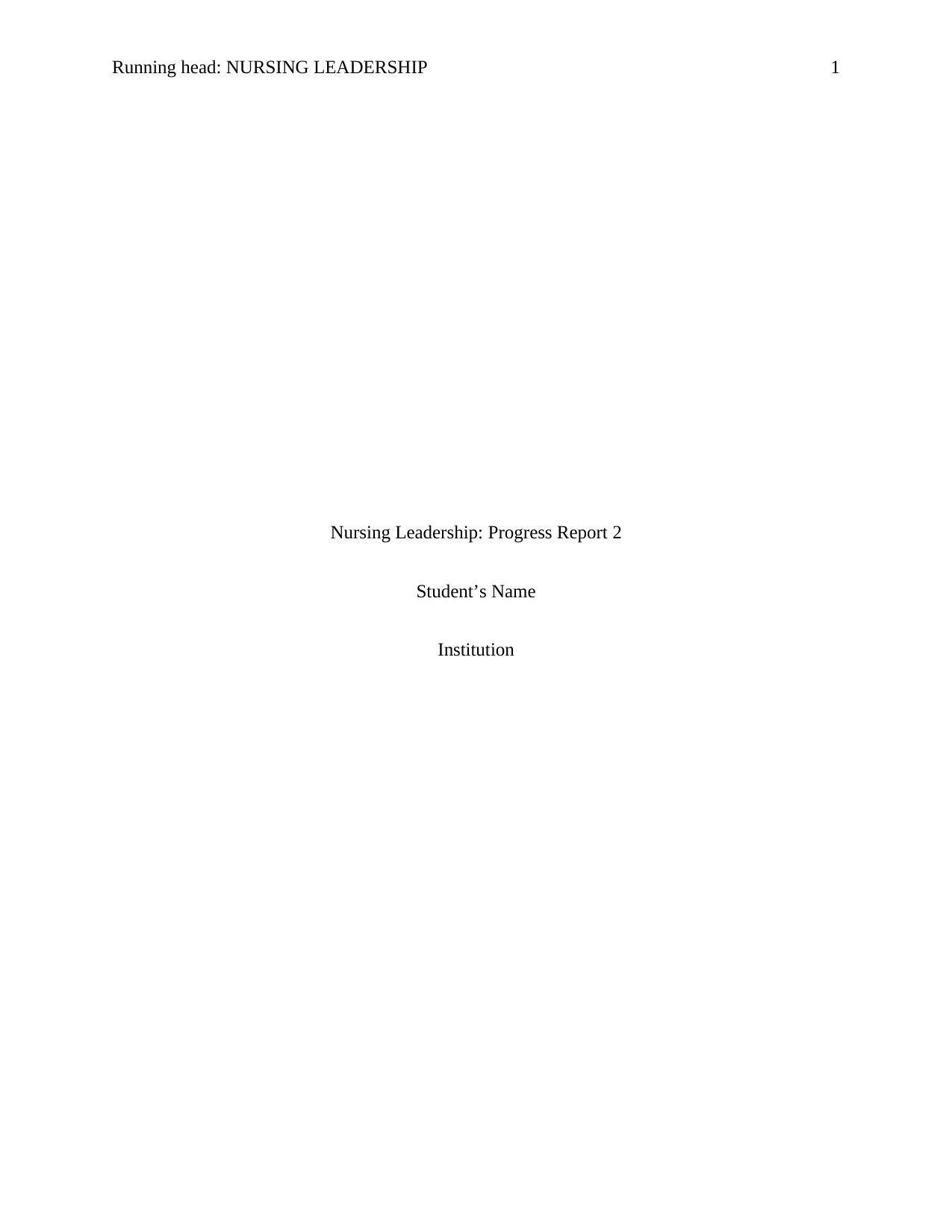
Running head: NURSING LEADERSHIP 1
Nursing Leadership: Progress Report 2
Student’s Name
Institution
Nursing Leadership: Progress Report 2
Student’s Name
Institution
Paraphrase This Document
Need a fresh take? Get an instant paraphrase of this document with our AI Paraphraser
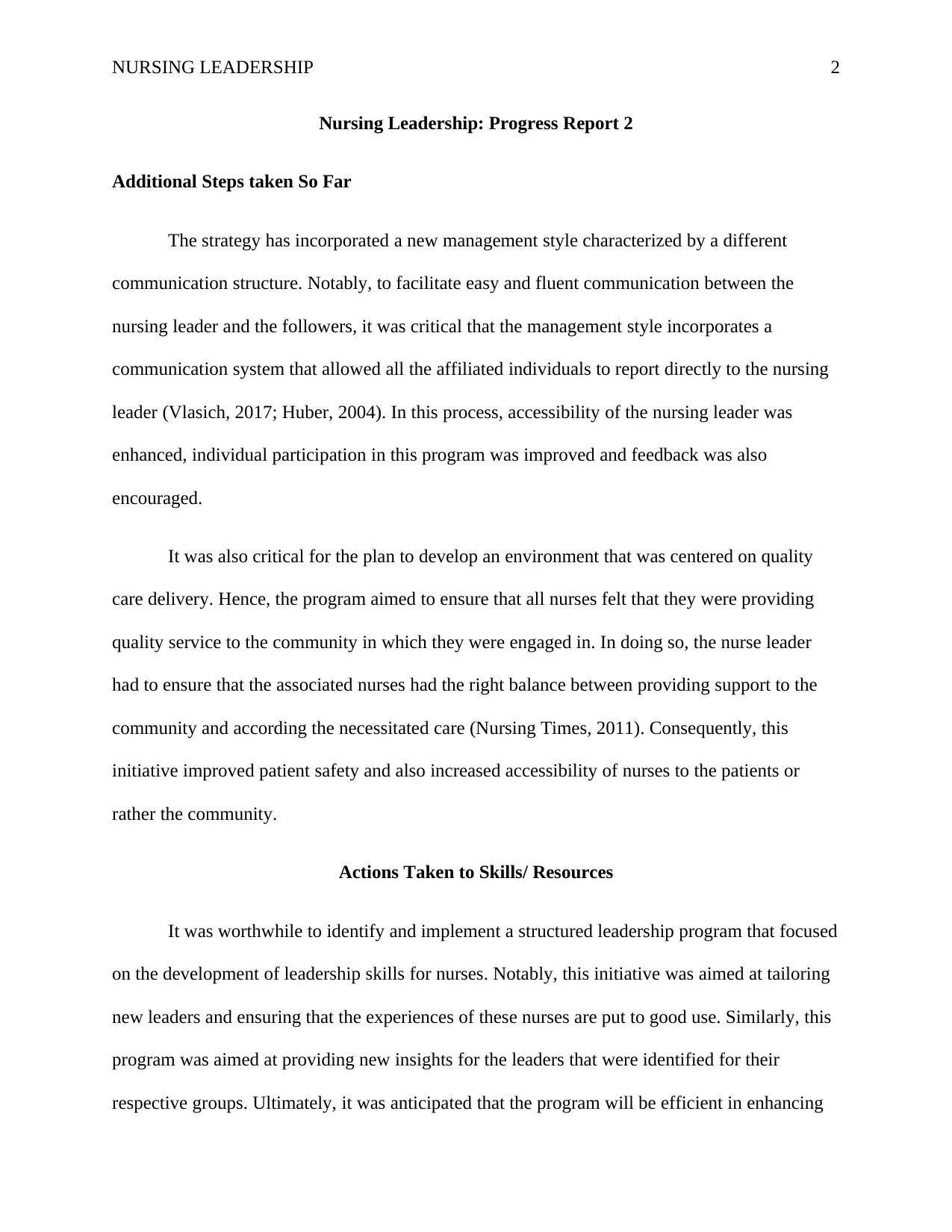
NURSING LEADERSHIP 2
Nursing Leadership: Progress Report 2
Additional Steps taken So Far
The strategy has incorporated a new management style characterized by a different
communication structure. Notably, to facilitate easy and fluent communication between the
nursing leader and the followers, it was critical that the management style incorporates a
communication system that allowed all the affiliated individuals to report directly to the nursing
leader (Vlasich, 2017; Huber, 2004). In this process, accessibility of the nursing leader was
enhanced, individual participation in this program was improved and feedback was also
encouraged.
It was also critical for the plan to develop an environment that was centered on quality
care delivery. Hence, the program aimed to ensure that all nurses felt that they were providing
quality service to the community in which they were engaged in. In doing so, the nurse leader
had to ensure that the associated nurses had the right balance between providing support to the
community and according the necessitated care (Nursing Times, 2011). Consequently, this
initiative improved patient safety and also increased accessibility of nurses to the patients or
rather the community.
Actions Taken to Skills/ Resources
It was worthwhile to identify and implement a structured leadership program that focused
on the development of leadership skills for nurses. Notably, this initiative was aimed at tailoring
new leaders and ensuring that the experiences of these nurses are put to good use. Similarly, this
program was aimed at providing new insights for the leaders that were identified for their
respective groups. Ultimately, it was anticipated that the program will be efficient in enhancing
Nursing Leadership: Progress Report 2
Additional Steps taken So Far
The strategy has incorporated a new management style characterized by a different
communication structure. Notably, to facilitate easy and fluent communication between the
nursing leader and the followers, it was critical that the management style incorporates a
communication system that allowed all the affiliated individuals to report directly to the nursing
leader (Vlasich, 2017; Huber, 2004). In this process, accessibility of the nursing leader was
enhanced, individual participation in this program was improved and feedback was also
encouraged.
It was also critical for the plan to develop an environment that was centered on quality
care delivery. Hence, the program aimed to ensure that all nurses felt that they were providing
quality service to the community in which they were engaged in. In doing so, the nurse leader
had to ensure that the associated nurses had the right balance between providing support to the
community and according the necessitated care (Nursing Times, 2011). Consequently, this
initiative improved patient safety and also increased accessibility of nurses to the patients or
rather the community.
Actions Taken to Skills/ Resources
It was worthwhile to identify and implement a structured leadership program that focused
on the development of leadership skills for nurses. Notably, this initiative was aimed at tailoring
new leaders and ensuring that the experiences of these nurses are put to good use. Similarly, this
program was aimed at providing new insights for the leaders that were identified for their
respective groups. Ultimately, it was anticipated that the program will be efficient in enhancing
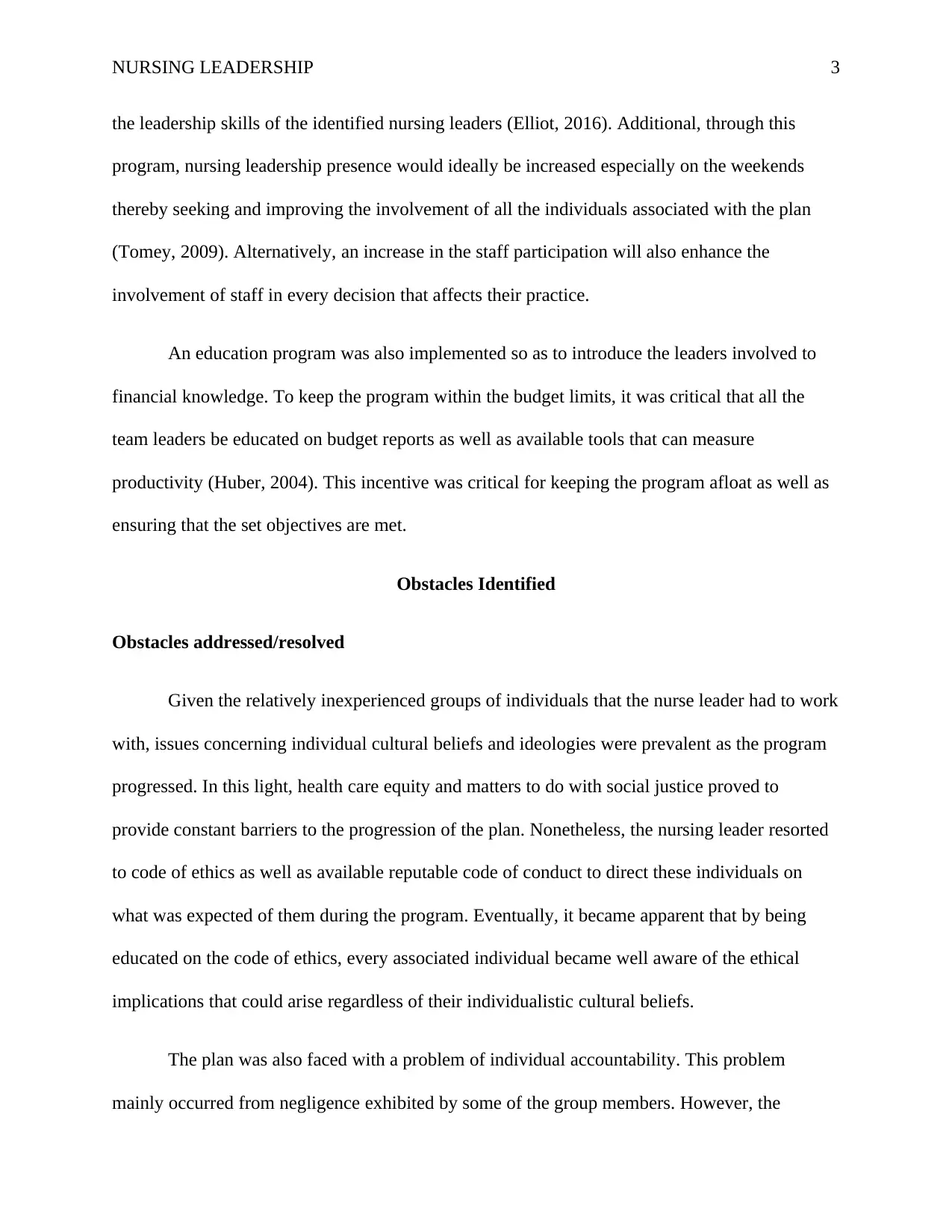
NURSING LEADERSHIP 3
the leadership skills of the identified nursing leaders (Elliot, 2016). Additional, through this
program, nursing leadership presence would ideally be increased especially on the weekends
thereby seeking and improving the involvement of all the individuals associated with the plan
(Tomey, 2009). Alternatively, an increase in the staff participation will also enhance the
involvement of staff in every decision that affects their practice.
An education program was also implemented so as to introduce the leaders involved to
financial knowledge. To keep the program within the budget limits, it was critical that all the
team leaders be educated on budget reports as well as available tools that can measure
productivity (Huber, 2004). This incentive was critical for keeping the program afloat as well as
ensuring that the set objectives are met.
Obstacles Identified
Obstacles addressed/resolved
Given the relatively inexperienced groups of individuals that the nurse leader had to work
with, issues concerning individual cultural beliefs and ideologies were prevalent as the program
progressed. In this light, health care equity and matters to do with social justice proved to
provide constant barriers to the progression of the plan. Nonetheless, the nursing leader resorted
to code of ethics as well as available reputable code of conduct to direct these individuals on
what was expected of them during the program. Eventually, it became apparent that by being
educated on the code of ethics, every associated individual became well aware of the ethical
implications that could arise regardless of their individualistic cultural beliefs.
The plan was also faced with a problem of individual accountability. This problem
mainly occurred from negligence exhibited by some of the group members. However, the
the leadership skills of the identified nursing leaders (Elliot, 2016). Additional, through this
program, nursing leadership presence would ideally be increased especially on the weekends
thereby seeking and improving the involvement of all the individuals associated with the plan
(Tomey, 2009). Alternatively, an increase in the staff participation will also enhance the
involvement of staff in every decision that affects their practice.
An education program was also implemented so as to introduce the leaders involved to
financial knowledge. To keep the program within the budget limits, it was critical that all the
team leaders be educated on budget reports as well as available tools that can measure
productivity (Huber, 2004). This incentive was critical for keeping the program afloat as well as
ensuring that the set objectives are met.
Obstacles Identified
Obstacles addressed/resolved
Given the relatively inexperienced groups of individuals that the nurse leader had to work
with, issues concerning individual cultural beliefs and ideologies were prevalent as the program
progressed. In this light, health care equity and matters to do with social justice proved to
provide constant barriers to the progression of the plan. Nonetheless, the nursing leader resorted
to code of ethics as well as available reputable code of conduct to direct these individuals on
what was expected of them during the program. Eventually, it became apparent that by being
educated on the code of ethics, every associated individual became well aware of the ethical
implications that could arise regardless of their individualistic cultural beliefs.
The plan was also faced with a problem of individual accountability. This problem
mainly occurred from negligence exhibited by some of the group members. However, the
You're viewing a preview
Unlock full access by subscribing today!
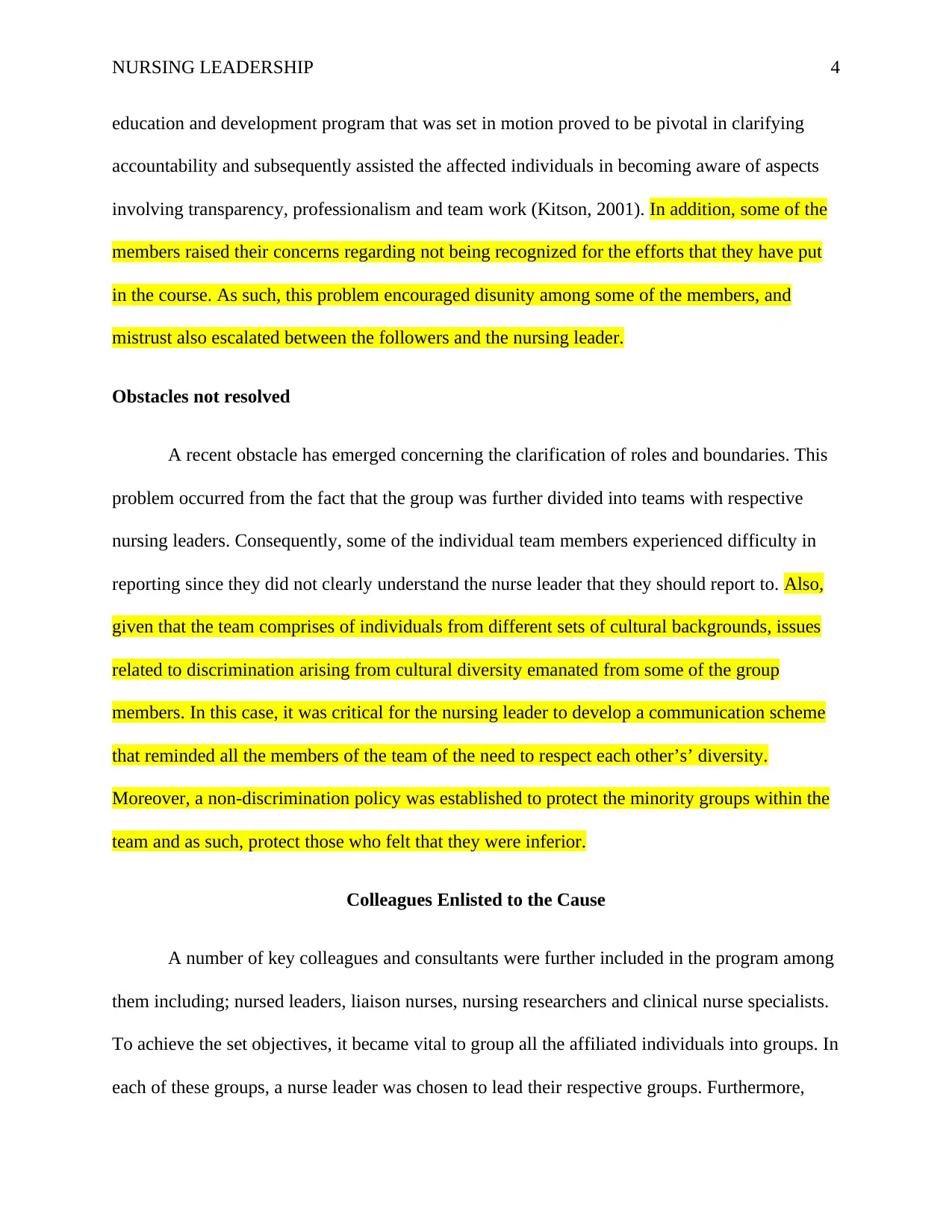
NURSING LEADERSHIP 4
education and development program that was set in motion proved to be pivotal in clarifying
accountability and subsequently assisted the affected individuals in becoming aware of aspects
involving transparency, professionalism and team work (Kitson, 2001). In addition, some of the
members raised their concerns regarding not being recognized for the efforts that they have put
in the course. As such, this problem encouraged disunity among some of the members, and
mistrust also escalated between the followers and the nursing leader.
Obstacles not resolved
A recent obstacle has emerged concerning the clarification of roles and boundaries. This
problem occurred from the fact that the group was further divided into teams with respective
nursing leaders. Consequently, some of the individual team members experienced difficulty in
reporting since they did not clearly understand the nurse leader that they should report to. Also,
given that the team comprises of individuals from different sets of cultural backgrounds, issues
related to discrimination arising from cultural diversity emanated from some of the group
members. In this case, it was critical for the nursing leader to develop a communication scheme
that reminded all the members of the team of the need to respect each other’s’ diversity.
Moreover, a non-discrimination policy was established to protect the minority groups within the
team and as such, protect those who felt that they were inferior.
Colleagues Enlisted to the Cause
A number of key colleagues and consultants were further included in the program among
them including; nursed leaders, liaison nurses, nursing researchers and clinical nurse specialists.
To achieve the set objectives, it became vital to group all the affiliated individuals into groups. In
each of these groups, a nurse leader was chosen to lead their respective groups. Furthermore,
education and development program that was set in motion proved to be pivotal in clarifying
accountability and subsequently assisted the affected individuals in becoming aware of aspects
involving transparency, professionalism and team work (Kitson, 2001). In addition, some of the
members raised their concerns regarding not being recognized for the efforts that they have put
in the course. As such, this problem encouraged disunity among some of the members, and
mistrust also escalated between the followers and the nursing leader.
Obstacles not resolved
A recent obstacle has emerged concerning the clarification of roles and boundaries. This
problem occurred from the fact that the group was further divided into teams with respective
nursing leaders. Consequently, some of the individual team members experienced difficulty in
reporting since they did not clearly understand the nurse leader that they should report to. Also,
given that the team comprises of individuals from different sets of cultural backgrounds, issues
related to discrimination arising from cultural diversity emanated from some of the group
members. In this case, it was critical for the nursing leader to develop a communication scheme
that reminded all the members of the team of the need to respect each other’s’ diversity.
Moreover, a non-discrimination policy was established to protect the minority groups within the
team and as such, protect those who felt that they were inferior.
Colleagues Enlisted to the Cause
A number of key colleagues and consultants were further included in the program among
them including; nursed leaders, liaison nurses, nursing researchers and clinical nurse specialists.
To achieve the set objectives, it became vital to group all the affiliated individuals into groups. In
each of these groups, a nurse leader was chosen to lead their respective groups. Furthermore,
Paraphrase This Document
Need a fresh take? Get an instant paraphrase of this document with our AI Paraphraser
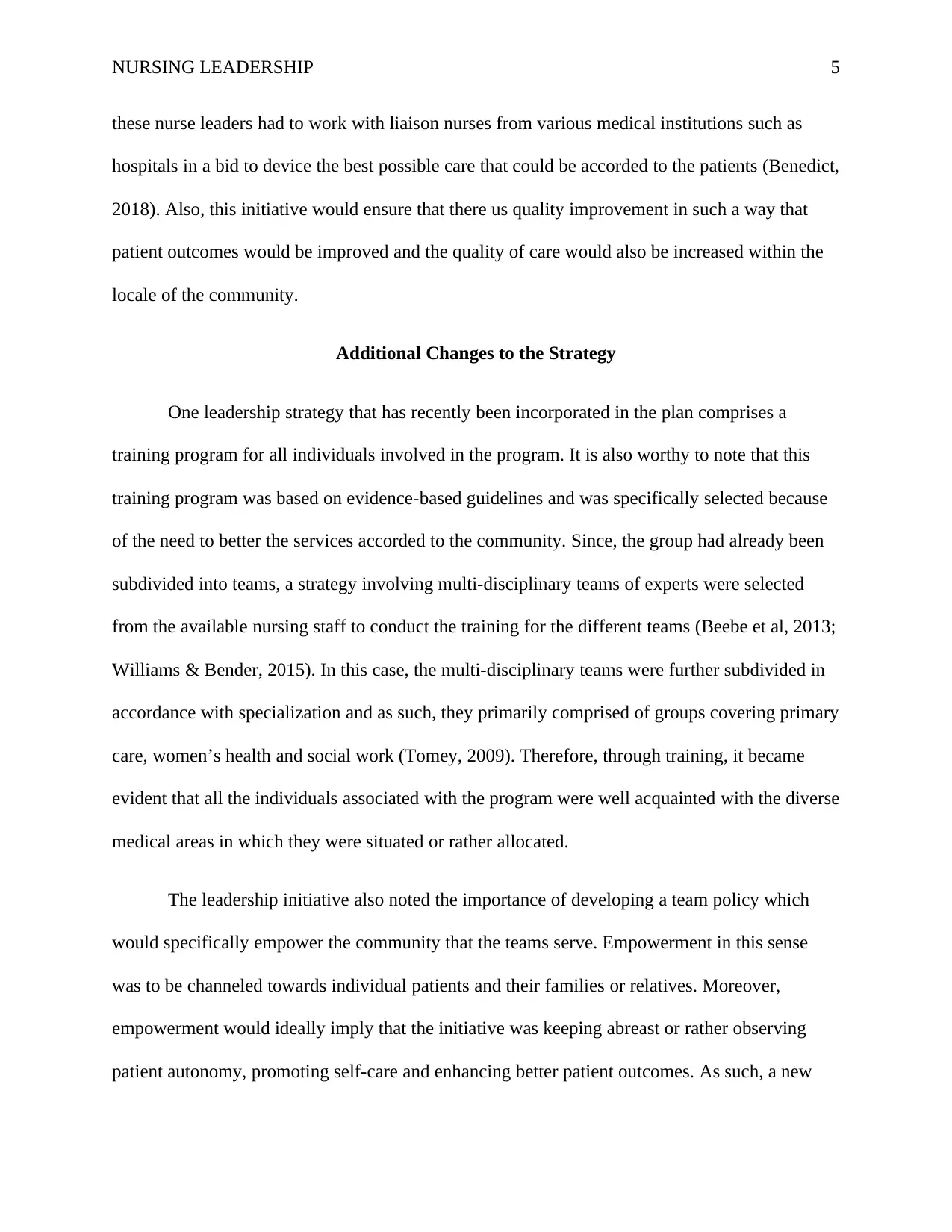
NURSING LEADERSHIP 5
these nurse leaders had to work with liaison nurses from various medical institutions such as
hospitals in a bid to device the best possible care that could be accorded to the patients (Benedict,
2018). Also, this initiative would ensure that there us quality improvement in such a way that
patient outcomes would be improved and the quality of care would also be increased within the
locale of the community.
Additional Changes to the Strategy
One leadership strategy that has recently been incorporated in the plan comprises a
training program for all individuals involved in the program. It is also worthy to note that this
training program was based on evidence-based guidelines and was specifically selected because
of the need to better the services accorded to the community. Since, the group had already been
subdivided into teams, a strategy involving multi-disciplinary teams of experts were selected
from the available nursing staff to conduct the training for the different teams (Beebe et al, 2013;
Williams & Bender, 2015). In this case, the multi-disciplinary teams were further subdivided in
accordance with specialization and as such, they primarily comprised of groups covering primary
care, women’s health and social work (Tomey, 2009). Therefore, through training, it became
evident that all the individuals associated with the program were well acquainted with the diverse
medical areas in which they were situated or rather allocated.
The leadership initiative also noted the importance of developing a team policy which
would specifically empower the community that the teams serve. Empowerment in this sense
was to be channeled towards individual patients and their families or relatives. Moreover,
empowerment would ideally imply that the initiative was keeping abreast or rather observing
patient autonomy, promoting self-care and enhancing better patient outcomes. As such, a new
these nurse leaders had to work with liaison nurses from various medical institutions such as
hospitals in a bid to device the best possible care that could be accorded to the patients (Benedict,
2018). Also, this initiative would ensure that there us quality improvement in such a way that
patient outcomes would be improved and the quality of care would also be increased within the
locale of the community.
Additional Changes to the Strategy
One leadership strategy that has recently been incorporated in the plan comprises a
training program for all individuals involved in the program. It is also worthy to note that this
training program was based on evidence-based guidelines and was specifically selected because
of the need to better the services accorded to the community. Since, the group had already been
subdivided into teams, a strategy involving multi-disciplinary teams of experts were selected
from the available nursing staff to conduct the training for the different teams (Beebe et al, 2013;
Williams & Bender, 2015). In this case, the multi-disciplinary teams were further subdivided in
accordance with specialization and as such, they primarily comprised of groups covering primary
care, women’s health and social work (Tomey, 2009). Therefore, through training, it became
evident that all the individuals associated with the program were well acquainted with the diverse
medical areas in which they were situated or rather allocated.
The leadership initiative also noted the importance of developing a team policy which
would specifically empower the community that the teams serve. Empowerment in this sense
was to be channeled towards individual patients and their families or relatives. Moreover,
empowerment would ideally imply that the initiative was keeping abreast or rather observing
patient autonomy, promoting self-care and enhancing better patient outcomes. As such, a new
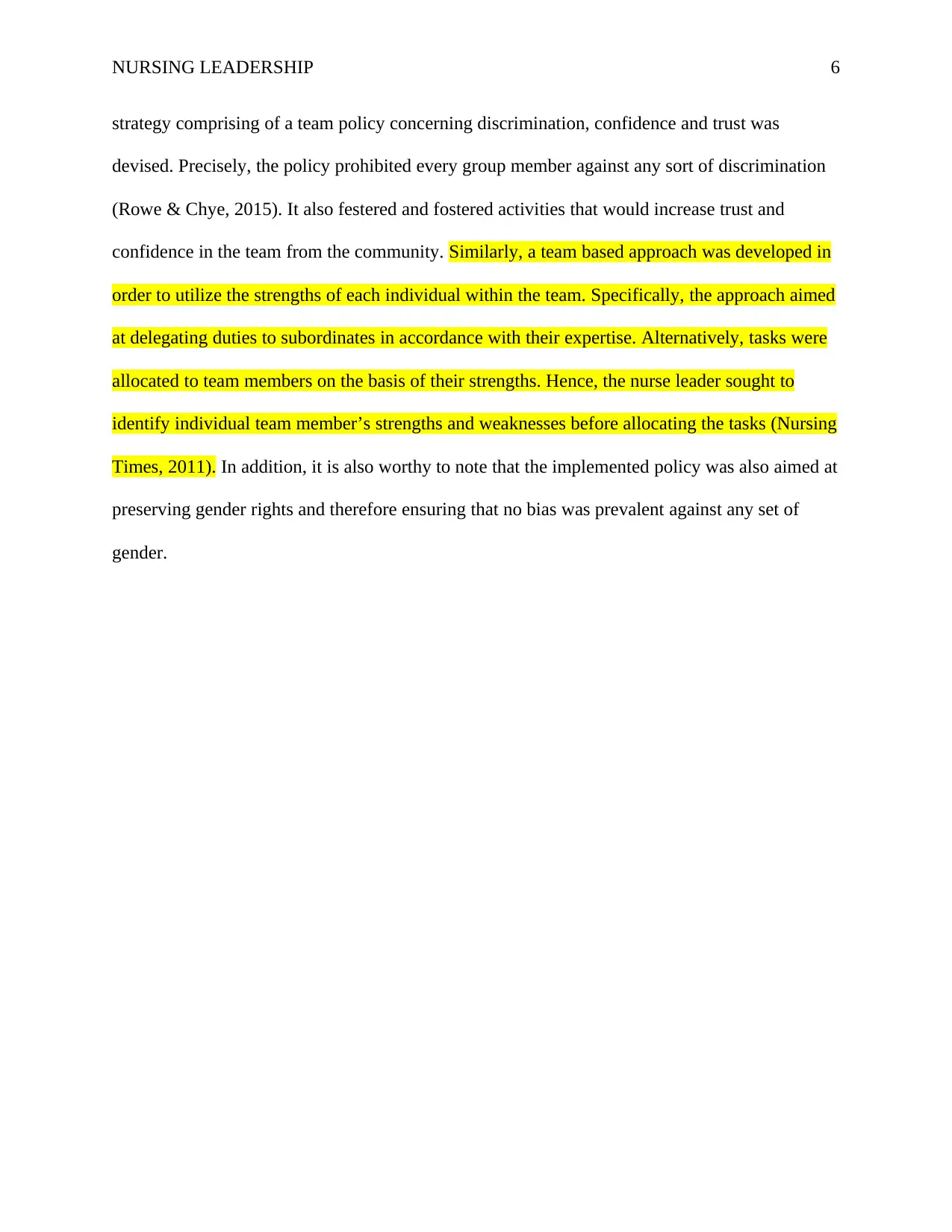
NURSING LEADERSHIP 6
strategy comprising of a team policy concerning discrimination, confidence and trust was
devised. Precisely, the policy prohibited every group member against any sort of discrimination
(Rowe & Chye, 2015). It also festered and fostered activities that would increase trust and
confidence in the team from the community. Similarly, a team based approach was developed in
order to utilize the strengths of each individual within the team. Specifically, the approach aimed
at delegating duties to subordinates in accordance with their expertise. Alternatively, tasks were
allocated to team members on the basis of their strengths. Hence, the nurse leader sought to
identify individual team member’s strengths and weaknesses before allocating the tasks (Nursing
Times, 2011). In addition, it is also worthy to note that the implemented policy was also aimed at
preserving gender rights and therefore ensuring that no bias was prevalent against any set of
gender.
strategy comprising of a team policy concerning discrimination, confidence and trust was
devised. Precisely, the policy prohibited every group member against any sort of discrimination
(Rowe & Chye, 2015). It also festered and fostered activities that would increase trust and
confidence in the team from the community. Similarly, a team based approach was developed in
order to utilize the strengths of each individual within the team. Specifically, the approach aimed
at delegating duties to subordinates in accordance with their expertise. Alternatively, tasks were
allocated to team members on the basis of their strengths. Hence, the nurse leader sought to
identify individual team member’s strengths and weaknesses before allocating the tasks (Nursing
Times, 2011). In addition, it is also worthy to note that the implemented policy was also aimed at
preserving gender rights and therefore ensuring that no bias was prevalent against any set of
gender.
You're viewing a preview
Unlock full access by subscribing today!
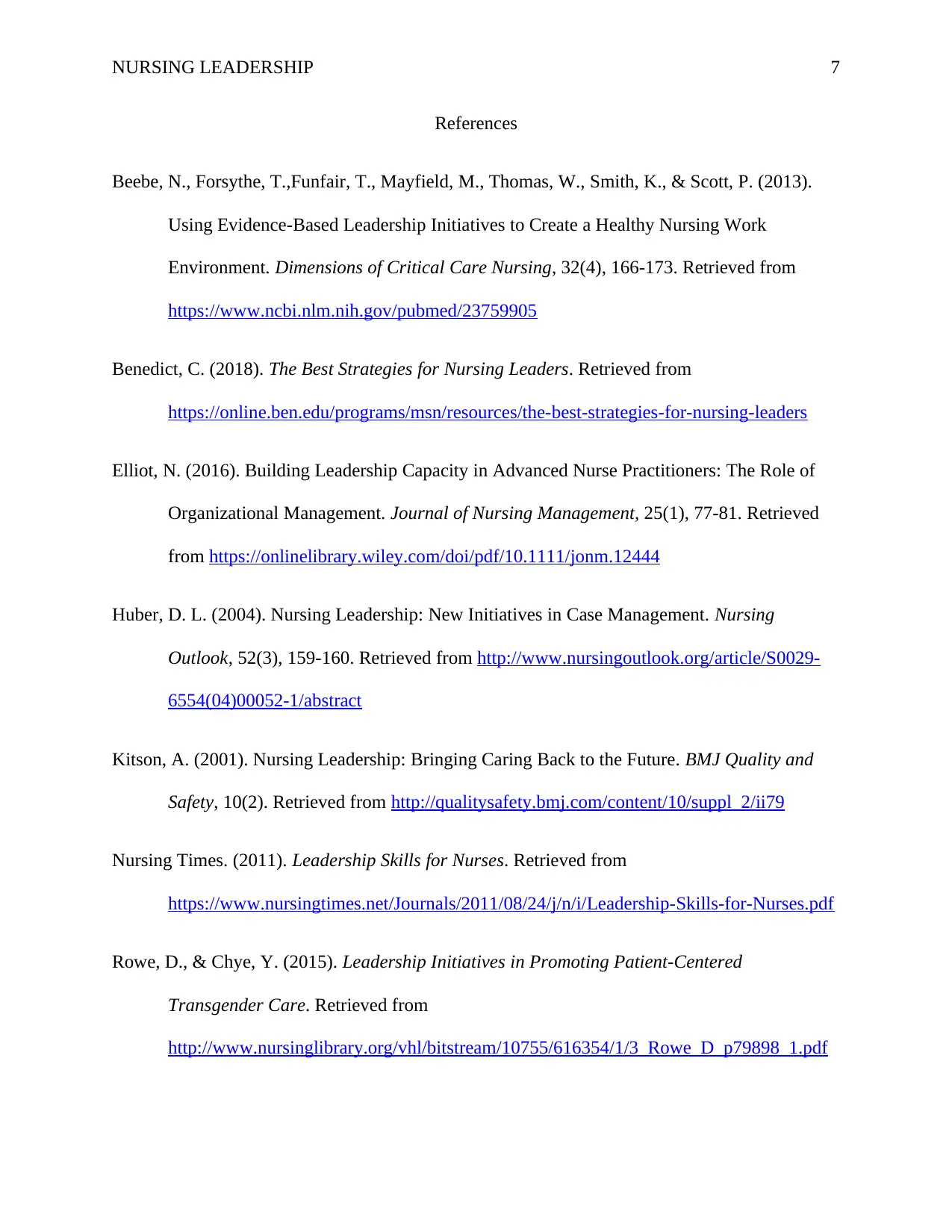
NURSING LEADERSHIP 7
References
Beebe, N., Forsythe, T.,Funfair, T., Mayfield, M., Thomas, W., Smith, K., & Scott, P. (2013).
Using Evidence-Based Leadership Initiatives to Create a Healthy Nursing Work
Environment. Dimensions of Critical Care Nursing, 32(4), 166-173. Retrieved from
https://www.ncbi.nlm.nih.gov/pubmed/23759905
Benedict, C. (2018). The Best Strategies for Nursing Leaders. Retrieved from
https://online.ben.edu/programs/msn/resources/the-best-strategies-for-nursing-leaders
Elliot, N. (2016). Building Leadership Capacity in Advanced Nurse Practitioners: The Role of
Organizational Management. Journal of Nursing Management, 25(1), 77-81. Retrieved
from https://onlinelibrary.wiley.com/doi/pdf/10.1111/jonm.12444
Huber, D. L. (2004). Nursing Leadership: New Initiatives in Case Management. Nursing
Outlook, 52(3), 159-160. Retrieved from http://www.nursingoutlook.org/article/S0029-
6554(04)00052-1/abstract
Kitson, A. (2001). Nursing Leadership: Bringing Caring Back to the Future. BMJ Quality and
Safety, 10(2). Retrieved from http://qualitysafety.bmj.com/content/10/suppl_2/ii79
Nursing Times. (2011). Leadership Skills for Nurses. Retrieved from
https://www.nursingtimes.net/Journals/2011/08/24/j/n/i/Leadership-Skills-for-Nurses.pdf
Rowe, D., & Chye, Y. (2015). Leadership Initiatives in Promoting Patient-Centered
Transgender Care. Retrieved from
http://www.nursinglibrary.org/vhl/bitstream/10755/616354/1/3_Rowe_D_p79898_1.pdf
References
Beebe, N., Forsythe, T.,Funfair, T., Mayfield, M., Thomas, W., Smith, K., & Scott, P. (2013).
Using Evidence-Based Leadership Initiatives to Create a Healthy Nursing Work
Environment. Dimensions of Critical Care Nursing, 32(4), 166-173. Retrieved from
https://www.ncbi.nlm.nih.gov/pubmed/23759905
Benedict, C. (2018). The Best Strategies for Nursing Leaders. Retrieved from
https://online.ben.edu/programs/msn/resources/the-best-strategies-for-nursing-leaders
Elliot, N. (2016). Building Leadership Capacity in Advanced Nurse Practitioners: The Role of
Organizational Management. Journal of Nursing Management, 25(1), 77-81. Retrieved
from https://onlinelibrary.wiley.com/doi/pdf/10.1111/jonm.12444
Huber, D. L. (2004). Nursing Leadership: New Initiatives in Case Management. Nursing
Outlook, 52(3), 159-160. Retrieved from http://www.nursingoutlook.org/article/S0029-
6554(04)00052-1/abstract
Kitson, A. (2001). Nursing Leadership: Bringing Caring Back to the Future. BMJ Quality and
Safety, 10(2). Retrieved from http://qualitysafety.bmj.com/content/10/suppl_2/ii79
Nursing Times. (2011). Leadership Skills for Nurses. Retrieved from
https://www.nursingtimes.net/Journals/2011/08/24/j/n/i/Leadership-Skills-for-Nurses.pdf
Rowe, D., & Chye, Y. (2015). Leadership Initiatives in Promoting Patient-Centered
Transgender Care. Retrieved from
http://www.nursinglibrary.org/vhl/bitstream/10755/616354/1/3_Rowe_D_p79898_1.pdf
Paraphrase This Document
Need a fresh take? Get an instant paraphrase of this document with our AI Paraphraser
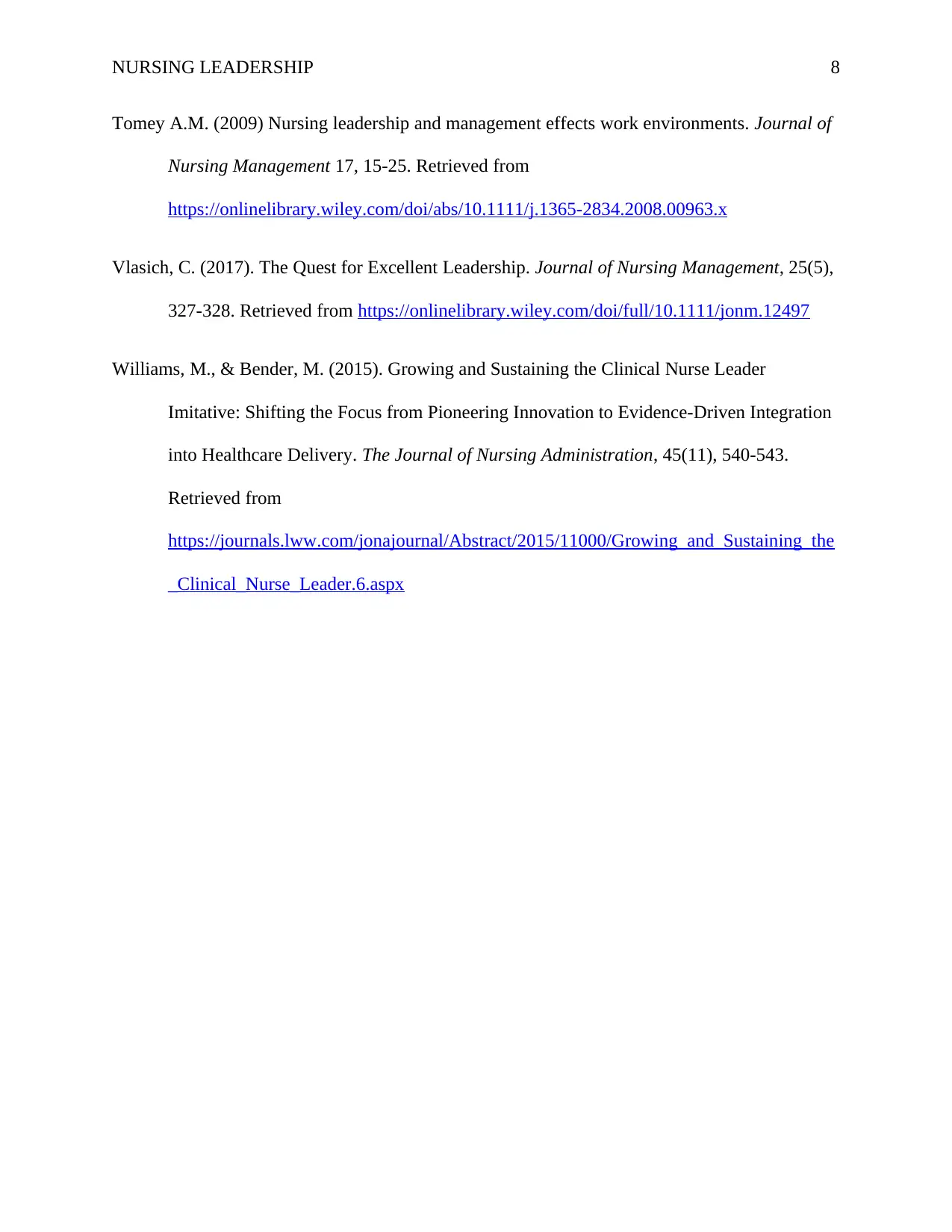
NURSING LEADERSHIP 8
Tomey A.M. (2009) Nursing leadership and management effects work environments. Journal of
Nursing Management 17, 15-25. Retrieved from
https://onlinelibrary.wiley.com/doi/abs/10.1111/j.1365-2834.2008.00963.x
Vlasich, C. (2017). The Quest for Excellent Leadership. Journal of Nursing Management, 25(5),
327-328. Retrieved from https://onlinelibrary.wiley.com/doi/full/10.1111/jonm.12497
Williams, M., & Bender, M. (2015). Growing and Sustaining the Clinical Nurse Leader
Imitative: Shifting the Focus from Pioneering Innovation to Evidence-Driven Integration
into Healthcare Delivery. The Journal of Nursing Administration, 45(11), 540-543.
Retrieved from
https://journals.lww.com/jonajournal/Abstract/2015/11000/Growing_and_Sustaining_the
_Clinical_Nurse_Leader.6.aspx
Tomey A.M. (2009) Nursing leadership and management effects work environments. Journal of
Nursing Management 17, 15-25. Retrieved from
https://onlinelibrary.wiley.com/doi/abs/10.1111/j.1365-2834.2008.00963.x
Vlasich, C. (2017). The Quest for Excellent Leadership. Journal of Nursing Management, 25(5),
327-328. Retrieved from https://onlinelibrary.wiley.com/doi/full/10.1111/jonm.12497
Williams, M., & Bender, M. (2015). Growing and Sustaining the Clinical Nurse Leader
Imitative: Shifting the Focus from Pioneering Innovation to Evidence-Driven Integration
into Healthcare Delivery. The Journal of Nursing Administration, 45(11), 540-543.
Retrieved from
https://journals.lww.com/jonajournal/Abstract/2015/11000/Growing_and_Sustaining_the
_Clinical_Nurse_Leader.6.aspx
1 out of 8
Related Documents
Your All-in-One AI-Powered Toolkit for Academic Success.
+13062052269
info@desklib.com
Available 24*7 on WhatsApp / Email
![[object Object]](/_next/static/media/star-bottom.7253800d.svg)
Unlock your academic potential
© 2024 | Zucol Services PVT LTD | All rights reserved.





